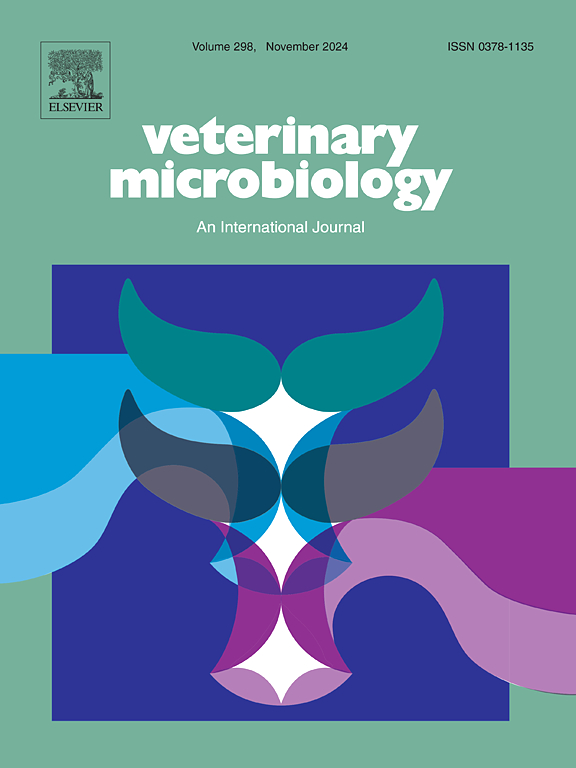Heterologous expression and immunological reactivity of the recombinant lipoprotein GUDIV-517 from Ureaplasma diversum
IF 2.7
2区 农林科学
Q3 MICROBIOLOGY
引用次数: 0
Abstract
Ureaplasma diversum infects cattle and plays a significant role in economic losses in the livestock sector, as it is associated with the development of reproductive and respiratory disorders in these animals. Studies have suggested that membrane-associated lipoproteins (LAMPs) are closely linked to the pathogenicity of these bacteria. Thus, this study aimed to express the lipoprotein GUDIV-517 from U. diversum (rGUDIV-517) in a heterologous system and evaluate the immunogenicity of this antigen in cultured bovine peripheral blood mononuclear cells (PBMC). The vector pET-28a (+) containing the gene sequence gudiv-517 was expressed in Escherichia coli BL21(DE3). The recombinant protein was inoculated into mice (BALB/c) to produce anti-rGUDIV-517 antibodies. Indirect ELISA verified immunogenicity. Quantification of nitric oxide (NO) and Hydrogen peroxide (H2O2) was performed in the PBMC culture supernatant, and expression analysis of IL-1β, TNF-α, TLR2, TLR4, iNOS, and caspase-3 genes was conducted by quantitative PCR (qPCR). This study demonstrated that booster doses of rGUDIV-517 induce increased IgG production and avidity. Recombinant GUDIV-517 also induced an upregulation of the immune response, characterized by increased H2O2 and NO production, as well as the expression of pro-inflammatory markers, in PBMC culture compared to the negative control. All these data make rGUDIV-517 a promising target for diagnostic tests and vaccine development against U. diversum.
分散尿原体重组脂蛋白GUDIV-517的异种表达及免疫反应性研究
憩室脲原体感染牛,并在畜牧部门的经济损失中发挥重要作用,因为它与这些动物的生殖和呼吸系统疾病的发展有关。研究表明,膜相关脂蛋白(lamp)与这些细菌的致病性密切相关。因此,本研究旨在异种系统中表达从大肠杆菌中提取的脂蛋白GUDIV-517 (rGUDIV-517),并评价该抗原在培养的牛外周血单核细胞(PBMC)中的免疫原性。在大肠杆菌BL21(DE3)中表达了含有gudiv-517基因序列的载体pET-28a(+)。将重组蛋白接种于小鼠(BALB/c),产生抗rgudiv -517抗体。间接ELISA验证免疫原性。在PBMC培养上清液中定量测定一氧化氮(NO)和过氧化氢(H2O2),并采用定量PCR (qPCR)分析IL-1β、TNF-α、TLR2、TLR4、iNOS和caspase-3基因的表达。本研究表明,rGUDIV-517增强剂量可诱导IgG的产生和活性增加。与阴性对照相比,重组GUDIV-517还诱导了PBMC培养中免疫反应的上调,其特征是H2O2和NO的产生增加,以及促炎标志物的表达增加。所有这些数据使rGUDIV-517成为针对大肠杆菌的诊断测试和疫苗开发的一个有希望的靶点。
本文章由计算机程序翻译,如有差异,请以英文原文为准。
求助全文
约1分钟内获得全文
求助全文
来源期刊

Veterinary microbiology
农林科学-兽医学
CiteScore
5.90
自引率
6.10%
发文量
221
审稿时长
52 days
期刊介绍:
Veterinary Microbiology is concerned with microbial (bacterial, fungal, viral) diseases of domesticated vertebrate animals (livestock, companion animals, fur-bearing animals, game, poultry, fish) that supply food, other useful products or companionship. In addition, Microbial diseases of wild animals living in captivity, or as members of the feral fauna will also be considered if the infections are of interest because of their interrelation with humans (zoonoses) and/or domestic animals. Studies of antimicrobial resistance are also included, provided that the results represent a substantial advance in knowledge. Authors are strongly encouraged to read - prior to submission - the Editorials (''Scope or cope'' and ''Scope or cope II'') published previously in the journal. The Editors reserve the right to suggest submission to another journal for those papers which they feel would be more appropriate for consideration by that journal.
Original research papers of high quality and novelty on aspects of control, host response, molecular biology, pathogenesis, prevention, and treatment of microbial diseases of animals are published. Papers dealing primarily with immunology, epidemiology, molecular biology and antiviral or microbial agents will only be considered if they demonstrate a clear impact on a disease. Papers focusing solely on diagnostic techniques (such as another PCR protocol or ELISA) will not be published - focus should be on a microorganism and not on a particular technique. Papers only reporting microbial sequences, transcriptomics data, or proteomics data will not be considered unless the results represent a substantial advance in knowledge.
Drug trial papers will be considered if they have general application or significance. Papers on the identification of microorganisms will also be considered, but detailed taxonomic studies do not fall within the scope of the journal. Case reports will not be published, unless they have general application or contain novel aspects. Papers of geographically limited interest, which repeat what had been established elsewhere will not be considered. The readership of the journal is global.
 求助内容:
求助内容: 应助结果提醒方式:
应助结果提醒方式:


